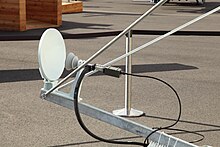Secondary mirror

The secondary mirror or secondary mirror is an optical element in reflecting telescopes , which by the main mirror reflected (primary mirror) rays from the telescope tube to come out eyepiece (observer camera) or deflected to the connected instruments.
Different mirror shapes
Depending on the type of telescope, the secondary mirrors have a different cut:
- The Newtonian telescope uses plane mirrors that direct the light just in front of the primary focus by 90 ° to the side, where the eyepiece socket is on the outside of the tube. Because the secondary mirror is mounted at an angle of 45 °, it usually has an elliptical shape (axis ratio 1: 0.707). Such mirrors are also needed for the Nasmyth and Coudé focus .
- The other types are concave or convex mirrors . The latter can be found in several types - both on observatories and on reflector telescopes for amateur astronomers :
- Convex mirrors are z. B. used in the Cassegrain telescope . They reflect the light through a hole in the main mirror, behind which the eyepiece is located. Due to their convex shape, they extend the focal length specified by the main mirror, similar to a Barlow lens . This and the double folding of the beam path make a very compact, temperature-resistant design possible. In order not to introduce spherical aberration , the secondary mirror of the Cassegrain telescope must be ground hyperbolically . The primary focus must coincide with the focal point of the hyperbola lying on the concave side , then the secondary focus is located at the location of the other hyperbola focal point .
- With catadioptric types such as Maksutov , Schmidt-Cassegrain or Schmidt-Newton telescopes for amateur astronomers , the auxiliary mirror is almost always on the corrector plate , which closes the tube towards the front. In Maksutov-Cassegrains , it often simply consists (according to Gregory) of a mirrored area around the middle of the back of the meniscus lens. The further beam path then runs through the hole in the main mirror like with other Cassegrains.
- Concave auxiliary mirrors are u. a. used to shorten the focal length - for example when a reflector telescope should also be used as a bright astrograph . However, the Gregory telescope , which has hardly been built any more, has a concave secondary mirror that extends the focal length and must be elliptically deformed in order not to produce spherical aberration.
Disadvantages of secondary mirror constructions
Depending on its size, a secondary mirror reduces the resolving power (selectivity) of the mirror telescope because the mirror edge and the struts with which it is attached in the telescope barrel cause additional light diffraction .
This is the reason why a lens telescope of the same size can better resolve double stars or fine details on planets. For example, a primary mirror with an aperture of 15-20 cm is necessary for a resolution of 1 " , while a 12 cm objective can do the same with a telescope. The larger reflector telescope is cheaper to manufacture than the smaller telescope.
To avoid this additional diffraction (which also causes the crossing silhouettes in bright stars), it is necessary to a. the Schiefspiegler was developed (System A. Kutter, Brachyt etc.)
